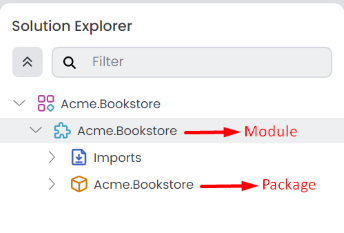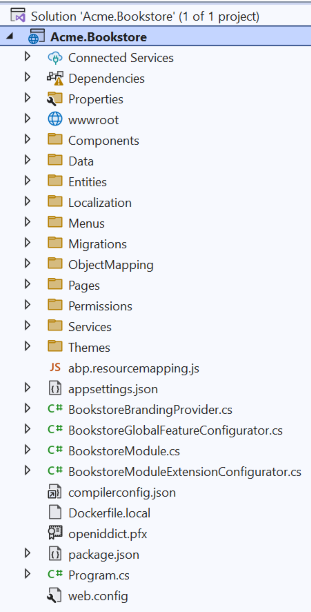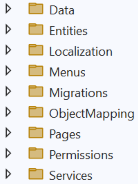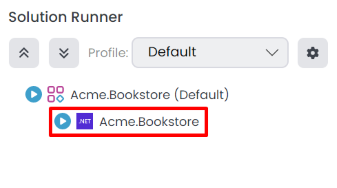Single Layer Solution: The Structure
Some of the features mentioned in this document may not be available in the free version. We're using the * symbol to indicate that a feature is available in the Team and Higher licenses.
This document explains the solution and folder structure of ABP Studio's single layer solution template.
This document assumes that you've created a new single-layer solution by following the Quick Start: Creating a Single Layer Web Application with ABP Studio guide. (Choose the Entity Framework Core as the database provider.)
Understanding the ABP Solution Structure
The single-layer solution template is designed to be simple and easy to understand. It includes a single project that contains all the necessary components to build a monolithic application. The solution structure is as follows:

Acme.Bookstore is the main ABP Studio module in the solution. It also includes the ABP Studio package Acme.Bookstore as the host application.
Refer to the Concepts document for a comprehensive definition of ABP Studio solution, module, and package terms.
The Solution Structure
If you create the solution based on Quick Start: Creating a Single Layer Web Application with ABP Studio guide, the solution structure will be as follows:

Folder Structure
This template uses a single-project structure, with concerns separated into folders instead of projects. The pre-defined folders are shown below:

- Data: Define your database mappings (for EF Core or MongoDB and repositories) in this folder.
- Entities: Define your entities in this folder.
- Localization: Define your UI localization keys/values in this folder.
- Menus: Define your UI menu items in this folder.
- Migrations: Contains the database migration files. It is created automatically by EF Core.
- ObjectMapping: Define your object-to-object mapping classes in this folder.
- Pages: Define your UI pages (Razor Pages) in this folder (create
ControllersandViewsfolders yourself if you prefer the MVC pattern). - Permissions: Define your permissions in this folder.
- Services: Define your application services in this folder.
How to Run?
When you create a new solution it automatically creates initial migration and run database migrator for you (unless you uncheck these options). However, you can run the following command in the directory of your project (in the same folder of the .csproj file) to create the database and seed the initial data:
dotnet run --migrate-database
This command will create the database and seed the initial data for you. Then you can run the application with the ABP Studio Solution Runner. The default username is admin and the password is 1q2w3E*.

While creating a database & applying migrations seem only necessary for relational databases, you should run this command even if you choose a NoSQL database provider (like MongoDB). In that case, it still seeds the initial data which is necessary for the application.


























































